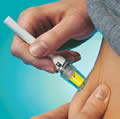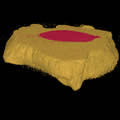Over 10 billion needle injections are given worldwide every year, yet they are disliked by most patients and are a safety hazard for patients and healthcare professionals. Indeed, there are over 600,000 needlestick injuries every year in the US to healthcare professionals, leading to the risk of infection by diseases such as hepatitis B, C and HIV. The idea of using needle-free injections has been around a long time, and indeed was used as long ago as the second world war. A mass-produced disposable product is now being developed by Weston Medical in conjunction with researchers at CUED.
Oliver Shergold, a PhD student working with Professor Norman Fleck, explains the issues:
"The needle-less syringe that has been developed by Weston Medical uses a compact nitrogen gas source to propel a pre-measured quantity of drug through the skin into the underlying tissue.The whole injection is complete in less than 60 milliseconds.
 |
 |
| Needle-less syringe in use. | Modelling distribution of the drug into the skin |
The syringe squirts a very fine jet of liquid at sufficient pressure to penetrate tissue. The initial pressure has to be high to penetrate the skin, followed by a lower pressure to pump the drug in. There are two aspects to the research in which engineers are involved: one is to make an instrument that is both safe and effective when manufactured in large quantities as a mass production item, and the second is to understand what is happening when the drug is injected.
My research focusses on designing well-constructed practical and theoretical experiments to prove that the drug is delivered in the way that is intended. We have to develop a good understanding of what exactly is happening, such as the effect of different paramenters on the distribution of the drug into the tissue (size of orifice and pressure of delivery for example).Analytical techniques such as the X-Ray computer tomography equipment in the Materials Lab are being used for our experiments, as well as the Stradx 3D ultrasound system to track the position of the drug after injection.
We are basically addressing a materials problem of the type engineers are used to, although in this case the materials in question are biological ones. The idea is to develop a mechanical model of the injection:we are also developing an artificial model of skin using rubber, so that this can be used for trials."